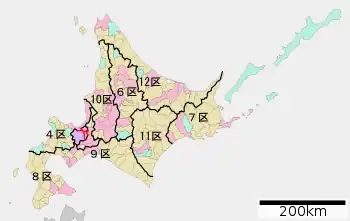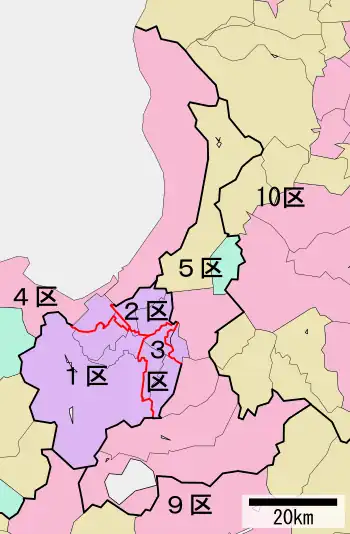List of districts of the House of Representatives of Japan
As of 2021, the House of Representatives of Japan is elected from a combination of multi-member districts and single-member districts, a method called Parallel voting. Currently, 176 members are elected from 11 multi-member districts (called proportional representation blocks or PR blocks) by a party-list system of proportional representation (PR), and 289 members are elected from single-member districts, for a total of 465. 233 seats are therefore required for a majority. Each PR block consists of one or more prefectures, and each prefecture is divided into one or more single-member districts. In general, the block districts correspond loosely to the major regions of Japan, with some of the larger regions (such as Kantō) subdivided.

History
| This article is part of a series on |
| Politics of Japan |
|---|
 |
|
|
Until the 1993 general election, all members of the House of Representatives were elected in multi-member constituencies by single non-transferable vote. In 1994, Parliament passed an electoral reform bill that introduced the current system of parallel voting in single-member constituencies and proportional voting blocks.[1] The original draft bill in 1993 by the anti-LDP coalition of Prime Minister Morihiro Hosokawa included proportional party list voting on a national scale, an equal number of proportional and district seats (250 each) and the possibility of split voting. However, the bill stalled in the House of Councillors.[2] After the Liberal Democratic Party (LDP) had returned to power later that year, it was changed to include proportional voting in regional blocks only, the number of proportional seats was reduced, but the possibility to cast two separate votes was kept in the bill. The electoral reform law was finally passed in 1994. It was first applied in the 1996 general election.
Redistricting and reapportionment
Amendments to the electoral law in 2002[3] and 2013[4] changed the boundaries of single-member districts and reapportioned seats between prefectures (+5/-5 in 2002; +0/-5 in 2013, resulting in a net change of -5 in district seats in the House of Representatives to 295 and overall seats to 475). The borders of the regional proportional blocks have never changed, but the apportionment of seats to the regional proportional blocks changed in 2000 after the number of proportional seats had been reduced from 200 to 180 (reducing the total number of seats in the lower house from 500 to 480),[5] and in the 2002 reapportionment.
Another reapportionment was passed by the National Diet in June 2017. In the majoritarian segment, it will change 97 districts in 19 prefectures, six are eliminated without replacement (one each in Aomori, Iwate, Mie, Nara, Kumamoto and Kagoshima). In the proportional segment, four "blocks" lose a seat each (Tōhoku, N. Kantō, Kinki, Kyūshū). Thus, the number of majoritarian seats is reduced to 289, the number of proportional seats to 176, the House of Representatives overall shrinks to 465. The reform takes effect one month after promulgation, i.e. on July 16, 2017.[6][7]
Hokkaidō (8 block seats)
The block constituency for Hokkaidō (比例北海道ブロック) elects 8 members proportionally. It contains only Hokkaidō Prefecture, which is divided into 12 single-member districts.
Hokkaidō Prefecture (12 districts)
Tohoku (13 block seats)
The block constituency for Tohoku (比例東北ブロック) elects 14 members proportionally. It corresponds to the Tohoku region.
Akita Prefecture (3 districts)
| District | Areas included | Number of constituents[8] | Current representative | Party represented | Map |
|---|---|---|---|---|---|
| District 1 | City of Akita | 260,836 | Hiroyuki Togashi[10] | LDP | 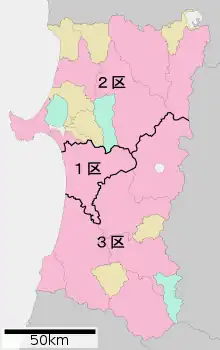 |
| District 2 | Cities of Katagami, Kazuno, Kitaakita, Noshiro, Ōdate and Oga
Districts of Kazuno, Kitaakita, Minamiakita and Yamamoto |
255,369 | Takashi Midorikawa[9] | CDP | |
| District 3 | Cities of Daisen, Nikaho, Semboku, Yokote, Yurihonjō and Yuzawa | 316,428 | Nobuhide Minorikawa[9] | LDP | |
Aomori Prefecture (3 districts)
| District | Areas included | Number of constituents[8] | Current representative | Party represented | Map |
|---|---|---|---|---|---|
| District 1 | Cities of Aomori and Mutsu
District of Higashitsugaru, Shimokita and part of district of Kamikita |
338,948 | Akinori Eto[17] | LDP | 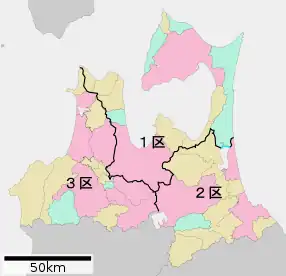 |
| District 2 | Cities of Hachinohe, Misawa and Towada
Part of district of Shimokita |
386,599 | Junichi Kanda[18] | LDP | |
| District 3 | Cities of Hirakawa, Hirosaki, Goshogawara, Kuroishi and Tsugaru
Districts of Kitatsugaru, Minamitsugaru, Nakatsugaru and Nishitsugaru |
344,106 | Jiro Kimura[18] | LDP | |
Fukushima Prefecture (4 districts)
| District | Areas included | Number of constituents[8] | Current representative | Party represented | Map |
|---|---|---|---|---|---|
| District 1 [changed 1] | Cities of Date, Fukushima, Motomiya and Nihonmatsu | 389,027 | Emi Kaneko[18] | CDP | 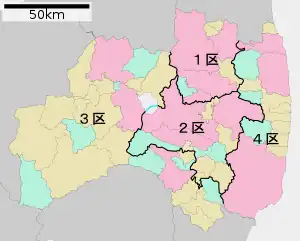 |
| District 2 [changed 1] | Cities of Kōriyama, Sukagawa and Tamura | 431,889 | Takumi Nemoto[11] | LDP | |
| District 3[changed 1] | Cities of Aizuwakamatsu, Kitakata and Shirakawa
District of Higashishirakawa, Kawanuma, Minamiaizu, Nishishirakawa, Ōnuma and Yama |
334,482 | Kōichirō Genba[19] | CDP | |
| District 4 [changed 1] | Cities of Iwaki, Minamisōma and Sōma | 408,290 | Shinji Oguma[15] | CDP | |
Iwate Prefecture (3 districts)
| District | Areas included | Number of Constitents | Current representative | Party represented | Map |
|---|---|---|---|---|---|
| 1st district | City of Morioka District of Shiwa |
294,318 | .svg.png.webp) | ||
| 2nd district[changed 3] | Cities of Kuji, Miyako, Rikuzentakata, Kamaishi, Ofunato, Tono, Hachimantai, Takizawa, and Ninohe Districts of Iwate, Kunohe, Ninohe, Kesen, and Shimohei |
376,270 | |||
| 3rd district[changed 3] | Cities of Ichinoseki, and Oshu, Esashi, Hanamaki, Kitakami and Mizusawa Districts of Higashiiawai, Kamihei, Hienuki, Isawa, Waga, and Nishiiwai |
380,161 | |||
Miyagi Prefecture (5 districts)
| District | Areas included | Number of Constitents[20] | Current representative | Party represented | Map |
|---|---|---|---|---|---|
| 1st district[changed 1] | Part of the city of Sendai (wards of Aoba-ku and Taihaku-ku). | 437,128 | Tōru Doi[21] | LDP |  |
| 2nd district | Part of the city of Sendai (wards of Izumi-ku, Miyagino-ku and Wakabayashi-ku). | 454,848 | Ken'ya Akiba[22] | LDP | |
| 3rd district [changed 1] | Cities of Iwanuma, Kakuda, Natori, and Shiroishi Districts of Igu, Katta, Shibata, and Watari |
288,807 | Akihiro Nishimura[23] | LDP | |
| 4th district [changed 1] | Cities of Furukawa, Shiogama, and Tagajō Districts of Kami, Kurokawa, Miyagi, and Shida |
238,625 | Shintarō Itō[24] | LDP | |
| 5th district [changed 1] | City of Ishinomaki Districts of Oshika and Tōda |
255,765 | Jun Azumi[22] | CDP | |
| 6th district | Cities of Kesennuma, Kurihara, and Tome Districts of Motoyoshi, and Tamatsukuri |
257,090 | Itsunori Onodera[25] | LDP | |
Yamagata Prefecture (3 districts)
| District | Areas included | Number of Constitents[20] | Current representative | Party represented | Map |
|---|---|---|---|---|---|
| 1st district | Cities of Kaminoyama, Tendō, and Yamagata District of Higashimurayama |
305,999 | Toshiaki Endō[26] | LDP |  |
| 2nd district | Cities of Higashine, Murayama, Nagai, Nan'yō, Obanazawa, Sagae, and Yonezawa Districts of Higashiokitama, Kitamurayama, Nishimurayama, and Nishiokitama |
318,476 | Norikazu Suzuki[27] | LDP | |
| 3rd district | Cities of Sakata, Shinjō, and Tsuruoka Districts of Akumi, Higashitagawa, Mogami, and Nishitagawa |
292,162 | Ayuko Katō[28] | LDP | |
Kita- (North) Kanto (19 block seats)
The Northern Kanto proportional representation block (北関東) elects 20 members proportionally. It includes four prefectures in northern Kanto.
Gunma Prefecture (5 districts)
| District | Areas included | Number of Constitents[20] | Current representative | Party represented | Map |
|---|---|---|---|---|---|
| 1st district[changed 1] | Cities of Maebashi and Numata Districts of Seta and Tone Also includes the former towns of Kurohone and Niisato, now annexed into Kiryū. |
381,712 | Asako Omi | LDP[25] |  |
| 2nd district[changed 1] | Cities of Isesaki and Kiryū (except as above) Districts of Nitta, Sawa, and Yamada |
335,206 | Toshirō Ino | LDP[24] | |
| 3rd district [changed 1] | Cities of Ōta (except as above) and Tatebayashi District of Oura |
304,937 | Hiroyoshi Sasagawa | LDP[27] | |
| 4th district | Cities of Takasaki and Fujioka District of Tano |
296,709 | Tatsuo Fukuda | LDP[29] | |
| 5th district[changed 1] | Cities of Annaka, Shibukawa, and Tomioka Districts of Agatsuma, Gunma, Kanra, Kitagunma, and Usui |
306,133 | Yūko Obuchi | LDP[25] | |
Ibaraki Prefecture (7 districts)
| District | Areas included | Number of Constitents[20] | Current representative | Party represented | Map |
|---|---|---|---|---|---|
| 1st district[changed 1] | Cities of Chikusei, Kasama, Mito, and Shimotsuma
District of Makabe |
404,671 | Yoshinori Tadokoro | LDP[30] | 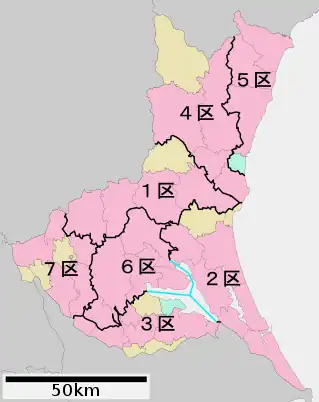 |
| 2nd district [changed 1] | Cities of Kashima and Itako
Districts of Higashiibaraki (except Shirosato), Kashima, Namegata, and Nishiibaraki (except Iwase) |
358,229 | Fukushirō Nukaga | LDP[23] | |
| 3rd district | Cities of Inashiki, Moriya, Ryūgasaki, Toride, and Ushiku | 390,819 | Yasuhiro Hanashi | LDP[31] | |
| 4th district[changed 3][changed 1] | Cities of Hitachinaka, Hitachiōmiya, Hitachiōta, and Naka | 270,634 | Hiroshi Kajiyama | LDP[28] | |
| 5th district[changed 3] | Cities of Hitachi, Kitaibaraki, and Takahagi | 244,671 | Akimasa Ishikawa | LDP[24] | |
| 6th district [changed 1] | Cities of Ishioka, Kasumigaura, Tsuchiura, Tsukuba, and Tsukubamirai | 452,067 | Ayano Kunimitsu | LDP[28] | |
| 7th district [changed 1] | Cities of Bandō, Koga, Mitsukaido, and Yuki | 305,971 | Kishirō Nakamura | Independent[23] | |
Saitama Prefecture (16 districts)
| District | Areas included | Number of Constitents[20] | Current representative | Party represented | Map |
|---|---|---|---|---|---|
| 1st district [changed 1] | Saitama city (wards of Iwatsuki-ku, Midori-ku, Minuma-ku, and Urawa-ku) | 461,964 | Hideki Murai[32] | LDP | 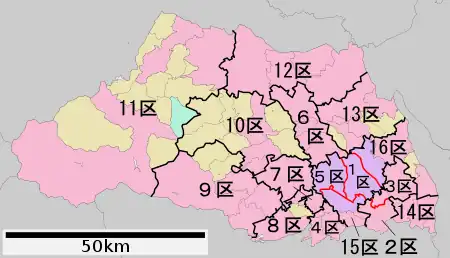 |
| 2nd district [changed 1] | Cities of Hatogaya and Kawaguchi | 470,382 | Yoshitaka Shindō[27] | LDP | |
| 3rd district[changed 1] | Cities of Koshigaya and Sōka | 461,155 | Hitoshi Kikawada[28] | LDP | |
| 4th district | Cities of Asaka, Niiza, Shiki, and Wakō | 385,295 | Yasushi Hosaka[31] | LDP | |
| 5th district[changed 1] | Saitama city (wards of: Chūō-ku, Kita-ku, Nishi-ku and Ōmiya-ku) | 393,806 | Yukio Edano[26] | CDP | |
| 6th district [changed 1] | Cities of Ageo, Kitamoto, Kōnosu, and Okegawa
Districts of Kitaadachi |
443,614 | Atsushi Ōshima[25] | Kibo | |
| 7th district [changed 1] | Cities of Fujimi, Kamifukuoka, and Kawagoe | 436,794 | Saichi Kamiyama[28] | LDP | |
| 8th district [changed 1] | City of Tokorozawa
Part of district of Iruma (including towns of Miyoshi and Ōi) |
366,333 | Masahiko Shibayama[27] | LDP | |
| 9th district | Cities of Hannō, Hidaka, Iruma, and Sayama
Part of district of Iruma (including towns of Moroyama and Ogose) |
406,785 | Taku Ōtsuka[25] | LDP | |
| 10th district | Cities of Higashimatsuyama, Sakado, and Tsurugashima
District of Hiki |
329,345 | Taimei Yamaguchi[33] | LDP | |
| 11th district [changed 1] | Cities of Chichibu, Fukaya, and Honjō
District of Chichibu and Kodama Part of district of Ōsato (including towns of Hanazono, Kawamoto, Kōnan, Okabe and Yorii) |
354,891 | Ryūji Koizumi[28] | LDP | |
| 12th district [changed 1] | Cities of Gyōda, Hanyū, Kazo, and Kumagaya
District of Kitasaitama Part of district of Ōsato (including towns of Menuma and Ōsato) |
372,182 | Atsushi Nonaka[23] | LDP | |
| 13th district [changed 1] | Cities of Hasuda, Kasukabe, and Kuki
District of Minamisaitama |
401,407 | Shinako Tsuchiya[30] | LDP | |
| 14th district [changed 1] | Cities of Misato, Satte, Yashio, and Yoshikawa
District of Kitakatsushika |
444,105 | Hiromi Mitsubayashi[32] | LDP | |
| 15th district [changed 1] | Saitama city (wards of Minami-ku and Sakura-ku) | 422,081 | Ryōsei Tanaka[30] | LDP | |
Tochigi Prefecture (5 districts)
| District | Areas included | Number of Constitents[20] | Current representative | Party represented | Map |
|---|---|---|---|---|---|
| 1st district [changed 1] | City of Utsunomiya
District of Kawachi (partially) Towns of Kaminokawa and Minamikawachi (in Kawachi district) |
435,121 | Hajime Funada | LDP[29] | 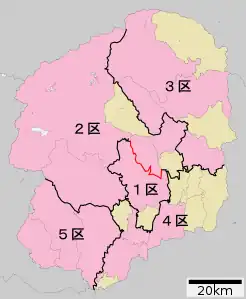 |
| 2nd district[changed 1] | Cities of Imaichi, Kanuma, Nikkō, and Sakura.
Districts of Kamitsuga, Shioya, and Kawachi (partially) Towns of Kamikawachi and Kawachi (in Kawachi district) |
264,743 | Akio Fukuda | Independent[29] | |
| 3rd district | Cities of Nasushiobara, Ōtawara, and Yaita
District of Nasu |
242,239 | Kazuo Yana | LDP[33] | |
| 4th district [changed 1] | Cities of Mooka and Oyama
Districts of Haga and Shimotsuga |
403,773 | Tsutomu Sato | LDP[27] | |
| 5th district [changed 1] | Cities of Ashikaga, Sano, and Tochigi | 286,780 | Toshimitsu Motegi | LDP[32] | |
Minami- (Southern) Kanto (22 block seats)
The block constituency for southern Kanto (比例南関東ブロック, hirei minami-Kantō burokku) elects 22 members proportionally. It includes two prefectures in southern Kanto and one in eastern Chubu.
Chiba Prefecture (14 districts)
| District | Areas included | Number of Constitents[34] | Current representative | Party represented | Map |
|---|---|---|---|---|---|
| 1st district | Chiba City (wards of Chūō-ku, Inage-ku, and Mihama-ku) | 427,315 |  | ||
| 2nd district [changed 1] | Chiba City (ward of Hanamigawa-ku) | 457,526 | |||
| 3rd district[changed 2] | Chiba City (ward of Midori-ku)
City of Ichihara |
337,348 | |||
| 4th district[changed 3][changed 1] | City of Funabashi | 461,492 | |||
| 5th district[changed 2][changed 1] | City of Urayasu
Part of the city of Ichikawa |
451,207 | |||
| 6th district[changed 2][changed 1] | Remainer of the city of Ichikawa
Part of the city of Matsudo |
370,008 | |||
| 7th district [changed 1] | Remainer of the city of Matsudo
Cities of Nagareyama and Noda |
431,924 | |||
| 8th district[changed 2][changed 1] | Cities of Kashiwa (except for the annexed Shōnan town) and Abiko | 421,712 | |||
| 9th district[changed 2] | Chiba City (ward of Wakaba-ku)
Cities of Sakura, Yachimata, and Yotsukaidō |
409,701 | |||
| 10th district [changed 1] | Cities of Asahi, Chōshi, Narita, Sawara, and Yōkaichiba | 346,693 | |||
| 11th district [changed 1] | Cities of Katsuura, Mobara, Tōgane | 355,958 | |||
| 12th district | Cities of Futtsu, Kamogawa, Kimitsu, Kisarazu, Sodegaura, and Tateyama
District of Awa |
383,846 | |||
| 13th district[changed 3][changed 4][changed 1] | Cities of Inzai, Kamagaya, Shiroi, and Tomisato
District of Iba district Part of the city of Kashiwa formerly comprising the annexed Shōnan town |
415,762 | |||
Kanagawa Prefecture (20 districts)
| District | Areas included | Number of Constitents[7] | Current representative | Party represented | Map |
|---|---|---|---|---|---|
| 1st district | Yokohama City (wards of Naka-ku, Isogo-ku, and Kanazawa-ku) | 428,847 |  | ||
| 2nd district | Yokohama City (wards of Kōnan-ku, Minami-ku, and Nishi-ku) | 436,063 | |||
| 3rd district | Yokohama City (wards of Kanagawa-ku and Tsurumi-ku) | 442,354 | |||
| 4th district | Yokohama City (ward of Sakae-ku)
Districts of Miura |
332,340 | |||
| 5th district [changed 1] | Yokohama City (wards of Izumi-ku, Seya-ku, and Totsuka-ku) | 466,918 | |||
| 6th district | Yokohama City (wards of Asahi-ku and Hodogaya-ku) | 382,249 | |||
| 7th district[changed 2][changed 1] | Yokohama City (wards of Kōhoku-ku and Tsuzuki-ku) | 445,940 | |||
| 8th district[changed 2][changed 1] | Yokohama City (wards of Midori-ku and Aoba-ku) | 426,564 | |||
| 9th district[changed 2][changed 1] | Kawasaki City (wards of Asao-ku and Tama-ku) | 336,328 | 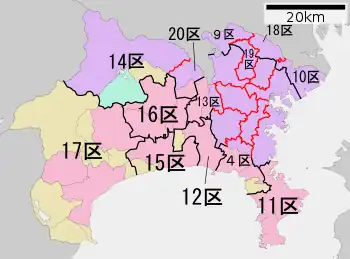 | ||
| 10th district[changed 3][changed 1] | Kawasaki city (wards of Kawasaki-ku, Nakahara-ku, and Saiwai-ku) | 471,623 | |||
| 11th district | Cities of Miura and Yokosuka. | 378,536 | |||
| 12th district | City of Fujisawa
District of Koza |
402,952 | |||
| 13th district [changed 1] | Cities of Ayase, Ebina, Yamato, and Zama | 469,949 | |||
| 14th district[changed 2][changed 1] | Parts of the city of Sagamihara | 459,727 | |||
| 15th district [changed 1] | Cities of Chigasaki and Hiratsuka | 472,627 | |||
| 16th district[changed 2][changed 1] | Cities of Atsugi and Isehara
Remainder of the city of Sagamihara |
467,271 | |||
| 17th district[changed 1] | Cities of Hadano, Minamiashigara, and Odawara
Districts of Ashigarakami and Ashigarashimo |
426,379 | |||
| 18th district[changed 4][changed 3][changed 1] | Kawasaki City (wards of Takatsu-ku and Miyamae-ku) | 449,201 | |||
Yamanashi Prefecture (2 districts)
| District | Areas included | Number of Constituents[20] | Current representative | Party represented | Map |
|---|---|---|---|---|---|
| District 1[changed 3] | Cities of Enzan, Kōfu, Nirasaki, Hokuto, Minami-arupusu, Chuo, Kai Districts of Higashiyamanashi, Nishiyatsushiro, Minamikoma, and Nakakoma |
426,140 |  | ||
| District 2[changed 3] | Cities of Yamanashi, Fujiyoshida, Ōtsuki, Tsuru, Fuefuki, Koshu, and Uenohara Districts of Kitatsuru and Minamitsuru |
264,495 |
Tokyo (17 block seats)
The block constituency for Tokyo (比例東京ブロック) elects 17 members proportionally. It covers Tokyo prefecture.
Tokyo Metropolis (30 districts)
| District | Areas included | Number of Constitents[20] | Current Representative | Party Represented | Map |
|---|---|---|---|---|---|
| 1st district[changed 1] | Tokyo wards of: Chiyoda, Minato and Shinjuku | 465,432 |  | ||
| 2nd district[changed 1] | Tokyo wards of: Chūō, Bunkyō and Taitō | 463,040 | |||
| 3rd district[changed 1] | Tokyo wards of: Shinagawa.
Parts of the ward of Ōta. Also includes the Izu Islands. |
473,543 | |||
| 4th district [changed 1] | The remainder of Ōta ward. | 478,229 | |||
| 5th district [changed 1] | Tokyo wards of: Meguro.
Parts of the ward of Setagaya. |
469,317 | |||
| 6th district[changed 1] | The remainder of Setagaya ward. | 470,024 | |||
| 7th district[changed 1] | Tokyo wards of: Shibuya and Nakano. | 463,238 | |||
| 8th district[changed 1] | Tokyo ward of: Suginami. | 480,517 | |||
| 9th district [changed 1] | Parts of the ward of Nerima. | 479,583 | |||
| 10th district[changed 1] | Tokyo ward of: Toshima.
The remainer of Nerima ward. |
481,534 | |||
| 11th district [changed 1] | Tokyo ward of: Itabashi. | 464,510 | |||
| 12th district [changed 1] | Tokyo wards of: Kita.
Parts of the ward of Adachi. |
466,598 | |||
| 13th district [changed 1] | The remainder of Adachi ward. | 480,876 |  | ||
| 14th district [changed 1] | Tokyo wards of: Sumida and Arakawa. | 466,618 | |||
| 15th district [changed 1] | Tokyo ward of: Kōtō. | 423,874 | |||
| 16th district [changed 1] | Parts of the ward of Edogawa. | 467,824 | |||
| 17th district[changed 1] | Tokyo wards of: Katsushika.
The remainder of Edogawa ward. |
477,742 | |||
| 18th district[changed 1] | Cities of: Musashino, Fuchū and Koganei. | 443,634 | |||
| 19th district [changed 1] | Cities of: Kodaira, Kokubunji, Kunitachi and Nishitōkyō | 437,625 | |||
| 20th district | Cities of: Higashimurayama, Higashiyamato, Kiyose, Higashikurume and Musashimurayama. | 417,563 | |||
| 21st district [changed 1] | Cities of: Tachikawa, Akishima and Hino. | 436,710 | |||
| 22nd district [changed 1] | Cities of: Mitaka, Chōfu, Komae and Inagi. | 477,909 | |||
| 23rd district [changed 1] | Cities of: Machida and Tama. | 458,093 | |||
| 24th district [changed 1] | City of: Hachiōji. | 461,848 | |||
| 25th district | Cities of: Ōme, Fussa, Hamura, Akiruno.
District of: Nishitama. |
415,548 | |||
Hokurikushinetsu (11 block seats)
The block constituency for Hokurikushinetsu (北陸信越) elects 11 members proportionally. It combines five prefectures of the Hokuriku and Shin'etsu subregions in northern Chubu.
Fukui Prefecture (2 districts)
| District | Areas included | Number of Constitents | Current representative | Party represented | Map |
|---|---|---|---|---|---|
| 1st district[changed 3] | Cities of: Fukui, Ono, Katsuyama, Awara, Sakai. |  | |||
| 2nd district[changed 3] | Cities of: Tsuruga, Obama, Echizen, and Sabae.
Districts of: Imadate, Mikata, Minamikaminaka, Nanjō, Nyū, Ōi, and Sakai. |
||||
Ishikawa Prefecture (3 districts)
| District | Areas included | Number of Constitents | Current representative | Party represented | Map |
|---|---|---|---|---|---|
| 1st district | City of Kanazawa | 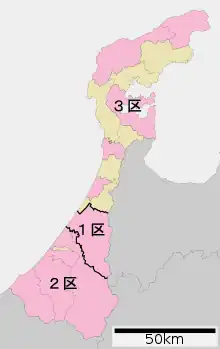 | |||
| 2nd district | Cities of: Hakusan, Kaga, Komatsu, and Nomi. | ||||
| 3rd district | Cities of: Hakui, Kahoku, Nanao, Suzu, and Wajima. | ||||
Niigata Prefecture (5 districts)
| District | Areas included | Number of Constitents | Current representative | Party represented | Map |
|---|---|---|---|---|---|
| 1st district[changed 2][changed 1] | City of Niigata (except for the recently annexed areas detailed under districts 2, 3, and 4). | 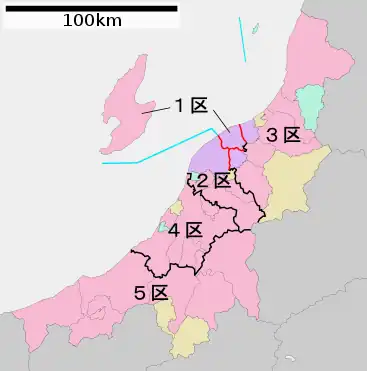 | |||
| 2nd district[changed 2][changed 1] | Cities of: Kashiwazaki, Sado, and Tsubame.
Parts of the city of Niigata (the former town of Nishikawa). Districts of: Kariwa, Nishikanbara, and Santō. The villages of Ajikata, Iwamuro, Katahigashi, Nakanokuchi and Tsukigata in Nishikanbara District. |
||||
| 3rd district [changed 1] | Cities of: Agano, Gosen, Murakami, and Shibata.
Districts of: Higashikanbara, Iwafune, Kitakanbara, and Nakakanbara. |
||||
| 4th district [changed 1] | Cities of: Kamo, Mitsuke, Sanjō, and Tochio.
District of Minamikanbara. Parts of the city of Niigata (the former towns of Niitsu and Shirone). The villages of Kameda, Kosudo and Yokogoshi in the Nakakanbara District. |
||||
| 5th district[changed 1] | Cities of: Minamiuonuma, Nagaoka, Ojiya, and Uonuma.
Districts of: Kitauonuma and Minamiuonuma. |
||||
| 6th district | Cities of: Itoigawa, Jōetsu, Myoko, and Tōkamachi.
District of Nakauonuma |
||||
Nagano Prefecture (5 districts)
| District | Areas included | Number of Constitents | Current representative | Party represented | Map |
|---|---|---|---|---|---|
| 1st district | Cities of: Iiyama, Nagano (except for the recently annexed areas in District 2), Nakano, and Suzaka.
Districts of: Kamitakai, Shimominochi, and Shimotakai. |
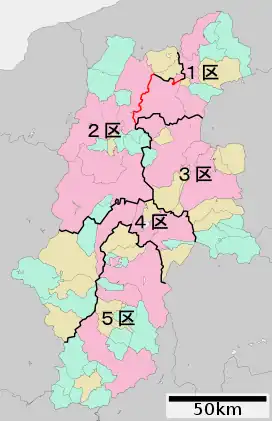 | |||
| 2nd district | Cities of: Matsumoto and Ōmachi.
Districts of: Higashichikuma, Kamiminochi, Kitaazumi, and Minamiazumi. Parts of the city of Nagano (the Sarashina district as well as the former towns of Kinasa, Togakushi, and Toyono previously in the Kamiminochi district). |
||||
| 3rd district | Cities of: Chikuma, Komoro, Saku, Tōmi and Ueda.
Districts of: Chiisagata, Hanishina, Kitasaku, and Minamisaku. |
||||
| 4th district | Cities of: Chino, Okaya, Shiojiri and Suwa. | ||||
| 5th district | Cities of: Iida, Ina and Komagane. | ||||
Toyama Prefecture (3 districts)
| District | Areas included | Number of Constitents | Current representative | Party represented | Map |
|---|---|---|---|---|---|
| 1st district | City of Toyama, except for the annexed areas included in District 2. | 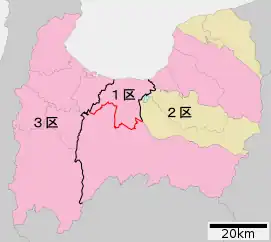 | |||
| 2nd district | Cities of: Kurobe, Namerikawa, and Uozu.
Districts of: Nakaniikawa and Shimoniikawa. Parts of the city of Toyama (the parts that formerly comprised the Kaminiikawa and Nei districts). |
||||
| 3rd district | Cities of: Himi, Nanto, Oyabe, Shinminato, Takaoka, and Tonami.
Districts of: Imizu and Nishitonami. |
||||
Tokai (21 block seats)
The block constituency for Tokai (東海) elects 21 members proportionally. It covers three prefectures in southern Chubu, as well as one prefecture in Kinki.

Aichi Prefecture (16 districts)
| District | Areas included | Number of Constitents | Current representative | Party represented |
|---|---|---|---|---|
| 1st district | Nagoya city wards of: Higashi, Kita, Nishi, and Naka. | |||
| 2nd district | Nagoya city wards of: Chikusa, Moriyama and Meitō. | |||
| 3rd district | Nagoya city wards of: Shōwa, Midori and Tenpaku. | |||
| 4th district | Nagoya city wards of: Mizuho, Atsuta, Minato and Minami. | |||
| 5th district[changed 2][changed 1] | Nagoya city wards of: Nakamura and Nakagawa.
Cities of Kiyosu and Kitanagoya. District of Nishikasugai. |
|||
| 6th district[changed 2][changed 1] | Cities of Kasugai, Inuyama and Komaki. | |||
| 7th district [changed 1] | Cities of Seto, Ōbu, Owariasahi, Toyoake, Nisshin.
District of Aichi. |
|||
| 8th district | Cities of Handa, Tokoname, Tōkai and Chita.
District of Chita. |
|||
| 9th district [changed 1] | ||||
| 10th district[changed 2][changed 1] | ||||
| 11th district [changed 1] | ||||
| 12th district | ||||
| 13th district | ||||
| 14th district [changed 1] | ||||
| 15th district | ||||
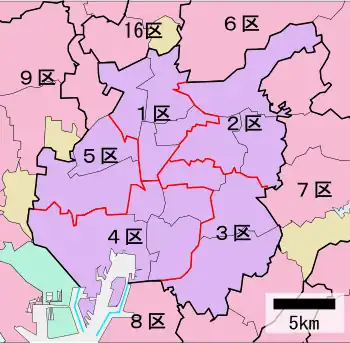 Aichi City in more detail
Aichi City in more detail- District 7 - Consists of the cities of Seto, Ōbu, Owariasahi, Toyoake, Nisshin as well as the district of Aichi.
- District 8 - Consists of the cities of Handa, Tokoname, Tōkai and Chita, as well as the district of Chita.
- District 9 - Consists of the cities of Tsushima, Inazawa, Aisai, Yatomi and Ichinomiya (region of the former city of Bisai), as well as the district of Ama.
- District 10[changed 2] - Consists of the part of Ichinomiya not included in District 9, the cities of Kōnan and Iwakura, as well as the district of Niwa.
- District 11 - Consists of the city of Toyota (except for the region of the former town of Inabu), as well as the district of Nishikamo.
- District 12 - Consists of the cities of Okazaki and Nishio, as well as the districts of Hazu and Nukata.
- District 13 - Consists of the cities of Hekinan, Kariya, Anjō, Chiryū and Takahama.
- District 14 - Consists of the cities of Toyokawa, Gamagōri, Shinshiro, Toyota (region of the former town of Inabu), as well as the districts of Kitashitara and Hoi.
- District 15 - Consists of the cities of Toyohashi and Tahara.

Gifu Prefecture (5 districts)
| District | Areas included | Number of Constitents | Current representative | Party represented |
|---|---|---|---|---|
| 1st district [changed 1] | ||||
| 2nd district | ||||
| 3rd district [changed 1] | ||||
| 4th district | ||||
| 5th district | ||||
- District 1 - Consists of the city of Gifu (except for the region of the former town of Yanaizu).
- District 2 - Consists of the cities of Ōgaki and Kaizu, as well as the districts of Yōrō, Fuwa, Anpachi and Ibi.
- District 3 - Consists of the cities of Seki, Mino, Hashima, Kakamigahara, Yamagata, Mizuho, Motosu and Gifu (region of the former town of Yanaizu), as well as the districts of Hashima and Motosu.
- District 4 - Consists of the cities of Takayama, Minokamo, Kani, Hida, Gujō and Gero, as well as the districts of Kamo, Kani and Ōno.
- District 5 - Consists of the cities of Tajimi, Nakatsugawa, Mizunami, Ena and Toki.
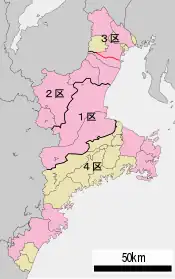
Mie Prefecture (4 districts)
| District | Areas included | Number of Constitents | Current representative | Party represented |
|---|---|---|---|---|
| 1st district | ||||
| 2nd district | ||||
| 3rd district | ||||
| 4th district | ||||
- District 1 - Consists of the cities of Tsu and Matsuaka.
- District 2 - Consists of the cities of Suzuka, Kameyama, Nabari, Iga, and parts of the city of Yokkaichi.
- District 3 - Consists of the cities of Kuwana, Inabe and Yokkaichi (parts not included in District 2), as well as the districts of Kuwana, Inabe and Mie.
- District 4 - Consists of the cities of Ise, Owase, Toba, Shima and Kumano, as well as the districts of Taki, Watarai, Kitamuro and Minamimuro.

Shizuoka Prefecture (8 districts)
| District | Areas included | Number of Constitents | Current representative | Party represented |
|---|---|---|---|---|
| 1st district [changed 1] | ||||
| 2nd district [changed 1] | ||||
| 3rd district [changed 1] | ||||
| 4th district [changed 1] | ||||
| 5th district [changed 1] | ||||
| 6th district [changed 1] | ||||
| 7th district [changed 1] | ||||
| 8th district [changed 1] | ||||
- District 1 - Consists of the wards of Aoi and Suruga in the city of Shizuoka.
- District 2 - Consists of the cities of Shimada, Yaizu, Fujieda, Makinohara and Omaezaki (part not included in District 3), as well as the districts of Shida and Haibara.
- District 3 - Consists of the ward of Tenryū (region of the former town of Haruno) in the city of Hamamatsu, the cities of Iwata, Fukuroi, Kakegawa, Kikugawa and Omaezaki (region of the former town of Hamaoka), as well as the district of Shūchi.
- District 4[changed 2] - Consists of the ward of Shimizu in the city of Shizuoka, the city of Fujinomiya, as well as the districts of Fuji and Ihara.
- District 5[changed 2] - Consists of the cities of Mishima, Fuji, Gotenba, Susono and Izunokuni (region of the former town of Izunagaoka), as well as the district of Tagata and the town of Oyama.
- District 6[changed 2] - Consists of the cities of Numazu, Atami, Itō, Shimoda, Izu and Izunokuni (parts not included in District 5), as well as the district of Kamo and the towns of Shimizu and Nagaizumi.
- District 7[changed 2] - Consists of the wards of Naka (region of the former towns of Nishioka and Hanagawa), Nishi, Minami (region of the former towns of Zōra, Takazuka, Higashiwakabayashi and Wakabayashi), Kita, Hamakita and Tenryū (parts not included in District 3) in the city of Hamamatsu, as well as the city of Kosai and the district of Hamana.
- District 8 - Consists of the wards of Naka (parts not included in District 7), Higashi and Minami (parts not included in District 7) in the city of Hamamatsu.
- (District 9)[changed 5] - Defunct
Kinki/Kansai (28 block seats)
The block constituency for Kinki (Kansai) (近畿) elects 29 members proportionally. It corresponds to the Kinki region minus Mie Prefecture.

Hyōgo Prefecture (12 districts)
| District | Areas included | Number of Constitents | Current representative | Party represented |
|---|---|---|---|---|
| 1st district | ||||
| 2nd district | ||||
| 3rd district | ||||
| 4th district | ||||
| 5th district [changed 1] | ||||
| 6th district [changed 1] | ||||
| 7th district | ||||
| 8th district | ||||
| 9th district | ||||
| 10th district | ||||
| 11th district | ||||
| 12th district | ||||
- District 1 - Consists of the wards of Chūō-ku, Higashinada-ku, and Nada-ku in Kobe.
- District 2 - Consists of the wards of Hyōgo-ku, Kita-ku, and Nagata-ku in Kobe.
- District 3 - Consists of the wards of Suma-ku and Tarumi-ku in Kobe.
- District 4 - Consists of Nishi-ku ward in Kobe, the cities of Kasai, Miki, Nishiwaki, and Ono, and the Katō, Mino and Taka districts.
- District 5 - Consists of the cities of Asago, Sanda, Sasayama, Tamba, Toyooka, and Yabu, and the Kawabe and Mikata districts.
- District 6 - Consists of the cities of Itami, Kawanishi and Takarazuka.
- District 7 - Consists of the cities of Ashiya and Nishinomiya.
- District 8 - Consists of the city of Amagasaki.
- District 9 - Consists of the cities of Akashi, Awaji, Minamiawaji, and Sumoto, as well as the Tsuna district.
- District 10 - Consists of the cities of Kakogawa and Takasago, as well as the Kako district.
- District 11 - Consists of the city of Himeji.
- District 12 - Consists of the cities of Aioi, Ako, Shiso, and Tatsuno, as well as the Akō, Ibo, Kanzaki, Sayō, Shikama and Shisō districts.

Kyoto Prefecture (6 districts)
| District | Areas included | Number of Constitents | Current representative | Party represented |
|---|---|---|---|---|
| 1st district | ||||
| 2nd district | ||||
| 3rd district | ||||
| 4th district | ||||
| 5th district | ||||
| 6th district | ||||
- District 1 - Consists of the wards of Kamigyō-ku, Kita-ku, Nakagyō-ku, Minami-ku, and Shimogyō-ku in Kyoto.
- District 2 - Consists of the wards of Higashiyama-ku, Sakyō-ku, and Yamashina-ku in Kyoto.
- District 3 - Consists of the ward of Fushimi-ku in Kyoto, the cities of Mukō and Nagaokakyō, and the Otokuni district.
- District 4 - Consists of the wards of Nishikyō-ku and Ukyō-ku in Kyoto, the city of Kameoka, and the Funai and Kitakuwada districts.
- District 5 - Consists of the cities of Ayabe, Fukuchiyama, Kyōtango, Maizuru, and Miyazu, as well as the Amata, Kasa, and Yosa districts.
- District 6 - Consists of the cities of Joyo, Kyōtanabe, Uji, and Yawata, as well as the Kuse, Sōraku, and Tsuzuki districts.

Nara Prefecture (3 districts)
| District | Areas included | Number of Constitents | Current representative | Party represented |
|---|---|---|---|---|
| 1st district | ||||
| 2nd district | ||||
| 3rd district | ||||
- District 1 - Consists of the cities of Ikoma and Nara (except for the recently annexed Tsuge village).
- District 2 - Consists of the cities of Ikoma, Kashiba, Tenri, and Yamatokōriyama, as well as the districts of Yamabe, Ikoma, Kitakatsuragi and Shiki. Also includes the part of Nara city that was formerly Tsuge village in the Yamabe district.
- District 3 - Consists of the cities of Gojō, Kashihara, and Sakurai, Gose, Katsuragi, and Yamatotakada, as well as the districts of Takaichi, Uda, and Yoshino.

Osaka Prefecture (19 districts)
| District | Areas included | Number of Constitents | Current representative | Party represented |
|---|---|---|---|---|
| 1st district | ||||
| 2nd district | ||||
| 3rd district | ||||
| 4th district | ||||
| 5th district | ||||
| 6th district | ||||
| 7th district | ||||
| 8th district [changed 1] | ||||
| 9th district [changed 1] | ||||
| 10th district | ||||
| 11th district | ||||
| 12th district | ||||
| 13th district | ||||
| 14th district | ||||
| 15th district | ||||
| 16th district | ||||
| 17th district | ||||
| 18th district | ||||
| 19th district | ||||
- District 1 - Consists of the wards of Chūō-ku, Ikuno-ku, Minato-ku, Naniwa-ku, Nishi-ku, and Tennōji-ku in Osaka city.
- District 2 - Consists of the wards of Abeno-ku, Higashisumiyoshi-ku, and Hirano-ku in Osaka city.
- District 3 - Consists of the wards of Nishinari-ku, Suminoe-ku, Sumiyosho-ku, and Taisho-ku in Osaka city.
- District 4 - Consists of the wards of Fukushima-ku, Higashinari-ku, Joto-ku, Kita-ku, and Miyakojima-ku in Osaka city.
- District 5 - Consists of the wards of Higashiyodogawa-ku, Konohana-ku, Nishiyodogawa-ku, and Yodogawa-ku in Osaka city.
- District 6 - Consists of the wards of Asahi-ku and Tsurumi-ku in Osaka city, as well as the cities of Kadoma and Moriguchi.
- District 7 - Consists of the cities of Settsu and Suita.
- District 8 - Consists of the city of Toyonaka.
- District 9 - Consists of the cities of Ibaraki, Ikeda, and Minoo, as well as the Toyono district.
 Detailed image of districts in Osaka City
Detailed image of districts in Osaka City - District 10 - Consists of the city of Takatsuki as well as the Mishima district.
- District 11 - Consists of the cities of Hirakata and Katano.
- District 12 - Consists of the cities of Daitō, Neyagawa, and Shijōnawate.
- District 13 - Consists of the city of Higashiōsaka.
- District 14 - Consists of the cities of Fujiidera, Habikino, Kashiwara, and Yao.
- District 15 - Consists of the cities of Kawachinagano, Matsubara, Ōsakasayama, and Tondabayashi, as well as the Minamikawachi district. Also contains the Mihara sector of Sakai city.
- District 16 - Consists of the Higashi, Kita, and Sakai sectors of Sakai city.
- District 17 - Consists of the areas of Sakai city not in districts 15 or 16.
- District 18 - Consists of the cities of Izumi, Izumiōtsu, Kishiwada, and Takaishi, as well as the Senboku district.
- District 19 - Consists of the cities of Hannan, Izumisano, Kaizuka, and Sennan, as well as the Sennan district.

Shiga Prefecture (3 districts)
| District | Areas included | Number of Constitents | Current representative | Party represented |
|---|---|---|---|---|
| 1st district | ||||
| 2nd district[changed 2][changed 1] | ||||
| 3rd district[changed 2][changed 1] | ||||
- District 1 - Consists of the cities of Ōtsu and Takashima as well as the Shiga district.
- District 2 - Consists of the cities of Hikone, Maibara and Nagahama as well as the Echi, Higashiazai, Ika, Inukami, and Sakata districts. Also includes the part of Higashiōmi that formerly comprised Aitō and Kotō in the Echi district.
- District 3 - Consists of the cities of Kusatsu, Moriyama, Rittō and Yasu.
- District 4 - Consists of the cities of Higashiōmi (except the parts listed in district 2), Kōka, Konan and Ōmihachiman as well as the Gamō and Kanzaki districts.
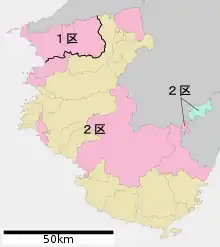
Wakayama Prefecture (2 districts)
| District | Areas included | Number of Constitents | Current representative | Party represented |
|---|---|---|---|---|
| 1st district [changed 1] | ||||
| 2nd district[changed 3][changed 1] | ||||
| 3rd district[changed 3] | ||||
Chugoku (11 block seats)
The block constituency for Chugoku (中国) elects 11 members proportionally. It corresponds to the Chugoku region.

Hiroshima Prefecture (6 districts)
| District | Areas included | Number of Constitents | Current representative | Party represented |
|---|---|---|---|---|
| 1st district[changed 1] | ||||
| 2nd district [changed 1] | ||||
| 3rd district [changed 1] | ||||
| 4th district [changed 1] | ||||
| 5th district [changed 1] | ||||
| 6th district [changed 1] | ||||
| 7th district | ||||
- District 1 - Consists of the Higashi-ku, Minami-ku, and Naka-ku wards in Hiroshima city.
- District 2 - Consists of the Nishi-ku and Saeki-ku wards in Hiroshima city, the cities of Etajima (except the original town of Etajima), Hatsukaichi, and Ōtake, and the Saeki district.
- District 3 - Consists of the Asakita-ku and Asaminami-ku wards in Hiroshima city, the city of Akitakata, and the Yamagata district.
- District 4 - Consists of the Aki-ku ward in Hiroshima city and the Aki district. Also, it includes parts of the cities of Kure (the former towns of Kamagari, Kurahashi, Ondo, and Shimokamagari), Higashihiroshima (all except for the former Akitsu town), Mihara (the former Daiwa town), and Etajima (the original Etajima town).
- District 5 - Consists of Takehara city and the Toyota district. Also includes Kure (except as in District 4), the part of Higashihiroshima comprising the former Akitsu town, and the part of Mihara comprising the former Hongō town.
- District 6 - Consists of the cities of Fuchū, Innoshima, Miyoshi, Onomichi, and Shōbara, as well as the Jinseki and Sera districts. Also includes the part of Mihara comprising the former Kui town.
- District 7 - Consists of the city of Fukuyama and the Fukayasu district.
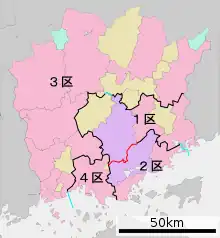
Okayama Prefecture (4 districts)
| District | Areas included | Number of Constitents | Current representative | Party represented |
|---|---|---|---|---|
| 1st district [changed 1] | ||||
| 2nd district [changed 1] | ||||
| 3rd district [changed 1] | ||||
| 4th district[changed 1] | ||||
| 5th district | ||||
- District 1 - Consists of parts of the city of Okayama, as well as the town of Kibichūō (region of the former town of Kamogawa).
- District 2 - Consists of the cities of Okayama (parts not included in Districts 1 and 3), Tamano and Setouchi.
- District 3 - Consists of the cities of Tsuyama, Bizen, Akaiwa, Maniwa (part not included in District 5), Mimasaka and Okayama (region of the former town of Seto), as well as the districts of Wake, Maniwa, Tomata, Katsuta, Aida and Kume.
- District 4 - Consists of the city of Kurashiki (parts not included in District 5) and the district of Tsukubo.
- District 5 - Consists of the cities of Kasaoka, Ibara, Sōja, Takahashi, Niimi, Maniwa (region of the former town of Hokubō), Kurashiki (region of the former towns of Funao and Mabi) and Asakuchi, as well as the districts of Asakuchi, Oda and the town of Kibichūō (part not included in District 1).
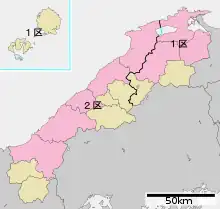
Shimane Prefecture (2 districts)
| District | Areas included | Number of Constitents | Current representative | Party represented |
|---|---|---|---|---|
| 1st district[changed 2][changed 1] | ||||
| 2nd district[changed 2][changed 1] | ||||
- District 1 - Consists of the cities of Matsue and Yasugi, the Nita, Oki and Yatsuka districts, the part of Unnan city formerly comprising Ohara, and the part of Izumo city formerly comprising Hirata.
- District 2 - Consists of the cities of Gōtsu, Hamada, Izumo (excluding former Hirata), Masuda, and Ōda, the Hikawa, Iishi, Kanoashi, Mino, Naka, Nima, and Ōchi districts, and the part of Unnan city formerly comprising Kakeya town, Mitoya town, and Yoshida village in the Iishi district.

Tottori Prefecture (2 districts)
| District | Areas included | Number of Constitents | Current representative | Party represented |
|---|---|---|---|---|
| 1st district[changed 3] | ||||
| 2nd district[changed 3] | ||||
- District 1 - Consists of the cities of Kurayoshi and Tottori, the Iwami, Ketaka, and Yazu districts, and the towns of Misasa and Yurihama in the Tōhaku district.
- District 2 - Consists of the cities of Sakaiminato and Yonago, the Hino and Saihaku districts, and the towns of Daiei, Hōjō, and Kotoura in the Tōhaku district.

Yamaguchi Prefecture (3 districts)
| District | Areas included | Number of Constitents | Current representative | Party represented |
|---|---|---|---|---|
| 1st district[changed 1] | ||||
| 2nd district[changed 1] | ||||
| 3rd district[changed 1] | ||||
| 4th district | ||||
- District 1 - Consists of the cities of Hōfu and Yamaguchi city (except for the annexed Atō town), as well as the part of Shūnan city formerly comprising Tokuyama, Shinnanyo, and Kano town.
- District 2 - Consists of the cities of Hikari, Iwakuni, Kudamatsu, and Yanai and the districts of Kuga, Kumage, and Ōshima, as well as the part of Shūnan city formerly comprising Kumage town.
- District 3 - Consists of the cities of Hagi, Mine, Sanyo-Onoda, and Ube and the Abu districts, as well as the part of Yamaguchi city formerly comprising Atō town.
- District 4 - Consists of the cities of Nagato and Shimonoseki.
Shikoku (6 block seats)
The block constituency for Shikoku (比例四国ブロック) elects 6 members proportionally. It corresponds to the Shikoku region.

Ehime Prefecture (3 districts)
| District | Areas Included | Number of constituents | Representative | Party represented | Map |
|---|---|---|---|---|---|
| District 1 [changed 1] | City of: Matsuyama, except for the recently annexed regions comprising the former Hōjō city and Nakajima town. |  | |||
| District 2[changed 3][changed 1] | Cities of Imabari, Iyo, and Tōon.
Districts of: Iyo, Kamiukena, and Ochi. Also includes the parts of Matsuyama comprising the former Hōjō city and Nakajima town, and the part of Uchiko comprising the former Oda town. |
||||
| District 3[changed 3][changed 1] | Cities of: Niihama, Saijō, and Shikokuchūō. | ||||
| District 4 | Cities of:f Ōzu, Seiyo, Uwajima, and Yawatahama.
Districts of: Kita (except for part of Uchiko in District 2), Kitauwa, Minamiuwa, and Nishiuwa. |
- District 1 - Consists of the city of Matsuyama, except for the recently annexed regions comprising the former Hōjō city and Nakajima town.
- District 2 - Consists of the cities of Imabari, Iyo, and Tōon, and the districts of Iyo, Kamiukena, Ochi. Also includes the parts of Matsuyama comprising the former Hōjō city and Nakajima town, and the part of Uchiko comprising the former Oda town.
- District 3[changed 3] - Consists of the cities of Niihama, Saijō, and Shikokuchūō.
- District 4 - Consists of the cities of Ōzu, Seiyo, Uwajima, and Yawatahama, as well as the districts of Kita (except for part of Uchiko in District 2), Kitauwa, Minamiuwa, and Nishiuwa.

Kagawa Prefecture (3 districts)
| District | Areas included | Number of Constitents | Current representative | Party represented |
|---|---|---|---|---|
| 1st district | ||||
| 2nd district | ||||
| 3rd district | ||||
- District 1 - Consists of Takamatsu city, the Shozu district, and Naoshima town in the Kagawa district.
- District 2 - Consists of the cities of Higashikagawa, Sakaide, and Sanuki, as well as the Ayauta, Kagawa (except Naoshima), and Kita districts.
- District 3 - Consists of the cities of Kan'onji, Marugame, and Zentsuji, as well as the Mitoyo and Nakatado districts.
Kōchi Prefecture (2 districts)
| District | Areas included | Number of Constitents | Current representative | Party represented | Map |
|---|---|---|---|---|---|
| 1st district[changed 2][changed 3] | Parts of the city of Kōchi. | 313,191 |  | ||
| 2nd district[changed 2][changed 3] | Rest of the city of Kōchi.
Cities of: Tosa, Susaki, Shimanto, Sukumo and Tosashimizu. |
291,892 | |||
Tokushima Prefecture (2 districts)
| District | Areas included | Number of Constitents | Current representative | Party represented | Map |
|---|---|---|---|---|---|
| 1st district[changed 2][changed 3] | Cities of: Tokushima, Komatsushima, and Anan. | 365,641 |  | ||
| 2nd district[changed 2][changed 3] | Cities of: Awa, Yoshinogawa, Naruto, Mima, and Miyoshi. | 263,940 | |||
Kyūshū (20 block seats)
The block constituency for Kyūshū (九州) elects 21 members proportionally. It includes all the prefectures on Kyūshū island, as well as Okinawa Prefecture.
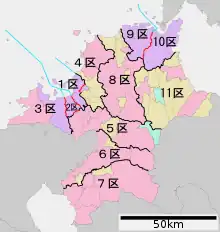
Fukuoka Prefecture (11 districts)
| District | Areas included | Number of Constitents | Current representative | Party represented |
|---|---|---|---|---|
| 1st district [changed 1] | ||||
| 2nd district | ||||
| 3rd district | ||||
| 4th district [changed 1] | ||||
| 5th district | ||||
| 6th district | ||||
| 7th district | ||||
| 8th district | ||||
| 9th district | ||||
| 10th district | ||||
| 11th district | ||||
- District 1 - Consists of the wards of Hakata-ku and Higashi-ku in Fukuoka.
- District 2 - Consists of the wards of Chūō-ku, Jonan-ku, and Minami-ku in Fukuoka.
- District 3 - Consists of the wards of Nishi-ku and Sawara-ku in Fukuoka, the city of Maebaru, and the Itoshima district.
- District 4 - Consists of the cities of Fukutsu, Koga, and Munakata, as well as the Kasuya district.
- District 5 - Consists of the cities of Amagi, Chikushino, Dazaifu, Kasuga, and Onojo, as well as the Asakura and Chikushi districts.
- District 6 - Consists of the cities of Kurume, Ogori, Okawa, and Ukiha, as well as the Mii and Mizuma districts.
- District 7 - Consists of the cities of Chikugo, Omuta, Yame, and Yanagawa, as well as the Miike, Yamato, and Yame districts.
- District 8 - Consists of the cities of Iizuka, Nakama, Nogata, and Yamada, as well as the Kaho, Kurate, and Onga districts.
- District 9 - Consists of the wards of Tobata-ku, Wakamatsu-ku, Yahatahigashi-ku, and Yahatanishi-ku in Kitakyushu.
- District 10 - Consists of the wards of Kokurakita-ku, Kokuraminami-ku, and Moji-ku in Kitakyushu.
- District 11 - Consists of the cities of Buzen, Tagawa, and Yukuhashi, as well as the Chikujō, Miyako, and Tagawa districts.

Kagoshima Prefecture (4 districts)
| District | Areas included | Number of Constitents | Current representative | Party represented |
|---|---|---|---|---|
| 1st district | ||||
| 2nd district | ||||
| 3rd district | ||||
| 4th district | ||||
- District 1 - Consists of the portions of Kagoshima city (the portions that are administered from: the main office and the Higashisakurajima, Ishiki, Yoshino, Sakurajima and Yoshida branch offices). Includes the former cities of Matsumoto and Koriyama that are now part of the city of Kagoshima. Additionally includes the Kagoshima district.
- District 2 - Consists of the remainder of Kagoshima city, the cities of Ibusuki, Makurazaki, Amami, Naze, Minamisatsuma, Minamikyushu, and the district of Ōshima.
- District 3 - Consists of the cities of Izumi, Akune, Hioki, Kaseda, Kushikino, Ichikikushikino, Isa, Aira and Satsumasendai, as well as the Aira, Hioki, Kawanabe, Satsuma, and Izumi districts.
- District 4 - Consists of the cities of Nishinoomote, Kanoya, Kokubu, Tarumizu, Soo, Shibushi, and Okuchi, as well as the Isa, Kimotsuki, Kumage, and Soo districts.

Kumamoto Prefecture (4 districts)
| District | Areas included | Number of Constitents | Current representative | Party represented |
|---|---|---|---|---|
| 1st district | ||||
| 2nd district | ||||
| 3rd district | ||||
| 4th district[changed 3] | ||||
- District 1 - Consists of part of the city of Kumamoto (the wards of Chuo, Higashi, and Kita)
- District 2 - Consists of the parts of Kumamoto city not in District 1 (the wards of Nishi and Minami), the cities Arao and Tamana, and the Tamana district.
- District 3 - Consists of the cities of Kochi, Aso, Kikuchi, and Yamaga, as well as the Aso, Kamimashiki, and Kikuchi districts.
- District 4 - Consists of the cities of Yatsushiro, Hitoyoshi, Minamata, Hondo, Kami-Amakusa, Uki, Ushibuka, and Uto, as well as the Ashikita, Kuma, Yatsushiro, Amakusa, Kamimashiki, and Shimomashiki districts.
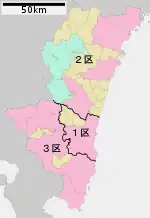
Miyazaki Prefecture (3 districts)
| District | Areas included | Number of Constitents | Current representative | Party represented |
|---|---|---|---|---|
| 1st district | City of Miyazaki, as well as the Higashimorokata and Miyazaki districts | |||
| 2nd district | ||||
| 3rd district | the cities of Ebino, Kobayashi, Kushima, Miyakonojo, and Nichinan, as well as the Kitamorokata, Minaminaka, and Nishimorokata districts. | |||
- District 1 - Consists of the city of Miyazaki, as well as the Higashimorokata and Miyazaki districts.
- District 2 - Consists of the cities of Hyuga, Nobeoka, and Saito, as well as the Higashiusuki, Koyu, and Nishiusuki districts.
- District 3 - Consists of the cities of Ebino, Kobayashi, Kushima, Miyakonojo, and Nichinan, as well as the Kitamorokata, Minaminaka, and Nishimorokata districts.

Nagasaki Prefecture (3 districts)
| District | Areas included | Number of Constitents | Current representative | Party represented |
|---|---|---|---|---|
| 1st district[changed 1] | ||||
| 2nd district[changed 1] | ||||
| 3rd district[changed 3][changed 1] | ||||
| 4th district[changed 3] | ||||
- District 1 - Consists of Nagasaki, except for the former Sotome town.
- District 2 - Consists of the cities of Isahaya, Saikai, and Shimabara, as well as the Nishisonogi and Minamitakaki districts, and the former Sotome town.
- District 3 - Consists of the cities of Gotō, Iki, Omura, and Tsushima, as well as the Higashisonogi and Minamimatsura districts.
- District 4[changed 3] - Consists of the cities of Hirado, Matsuura, and Sasebo, as well as the Kitamatsuura district.
Ōita Prefecture (3 districts)
| District | Areas included | Number of Constitents | Current representative | Party represented | Map |
|---|---|---|---|---|---|
| 1st district | City of Ōita (except for the former towns of Saganoseki and Notsuharu). | 382,349 | Yōichi Anami[22] | LDP | 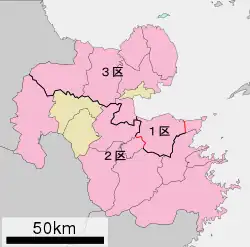 |
| 2nd district | Remainder of City of Ōita.
Cities of: Bungo-ōno, Hita, Saiki, Taketa, Tsukumi, Yufu, and Usuki. District of: Kusu. |
272,808 | Seishirō Etō[26] | LDP | |
| 3rd district | Cities of: Beppu, Bungotakada, Kitsuki, Nakatsu, Kunisaki, and Usa.
Districts of: Hayami, Higashikunisaki, and Nishikunisaki. |
305,166 | Takeshi Iwaya[24] | LDP | |
Okinawa Prefecture (4 districts)
| District | Areas included | Number of Constitents | Current representative | Party represented | Map |
|---|---|---|---|---|---|
| 1st district[changed 2] | City of: Naha.
Villages of: Tokashiki, Zamami, Aguni, Tonaki, Minamidaitō, Kitadaitō. Town of: Kumejima. Districts of: Shimajiri (partially). |
269,383 | Seiken Akamine[22] | Communist | 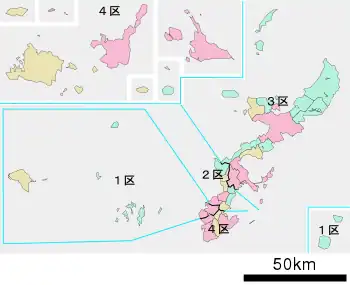 |
| 2nd district[changed 2] | Cities of: Ginowan and Urasoe.
District of: Nakagami. |
293,279 | Kantoku Teruya[30] | Social Democratic | |
| 3rd district[changed 2] | Cities of: Nago, Okinawa, Uruma.
Districts of: Kunigami. |
315,487 | Denny Tamaki[30] | Independent | |
| 4th district[changed 4] | Cities of: Miyakojima, Ishigaki, Itoman, Tomigusuku and Nanjō. | 293,818 | Kōsaburō Nishime[23] | LDP | |
Saga Prefecture (2 districts)
| District | Areas included | Number of Constitents[20] | Current representative | Party represented | Map |
|---|---|---|---|---|---|
| 1st district[changed 2][changed 3] | Cities of: Saga, Tosu, and Kanzaki (city).
Districts of: Miyaki and Kanzaki (district). |
334,354 | Hiroshi Ōgushi[25] | Kibo | 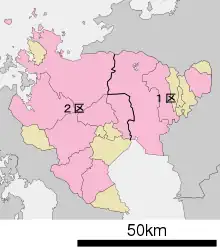 |
| 2nd district[changed 2][changed 3] | Cities of: Kashima, Ogi, Imari, Karatsu, Takeo, and Taku.
Districts of: Fujitsu, Kishima, Higashimatsuura, and Nishimatsuura. |
344,937 | Hideko Nishioka[23] | Kibo | |
See also
Notes
- Redistricted in 2022 (First effective in the 2025 Japanese General Election)
- Redistricted in 2002 (first effective in the 2003 House of Representatives election)
- Redistricted in 2013 (first effective in the 47th House of Representatives election)
- Created in the 2002 reapportionment (first effective in the 2003 House of Representatives election)
- Eliminated in the 2002 reapportionment (first effective in the 2003 House of Representatives election)
References
- "Japanese Pass Bills On Electoral Reform". The New York Times. 3 November 1993. Retrieved 2008-08-09.
- CRS: Issue Brief IB93100 in the Government Document Digital Collection of the University of North Texas
- MIC: 衆議院小選挙区の区割りの改定等について
- MIC: 衆議院小選挙区の区割りの改定等について
- MIC: 衆議院比例代表選出議員の定数削減について
- MIC: 衆議院小選挙区の区割りの改定等について
- NHK Senkyo Web: 衆院小選挙区 区割り見直し 改正公選法が成立
- "総務省|令和4年9月1日現在選挙人名簿及び在外選挙人名簿登録者数". 総務省 (in Japanese). Retrieved 2023-01-28.
- "Members M_The House of Representatives,Japan". www.shugiin.go.jp. Retrieved 2023-01-28.
- "Members T_The House of Representatives,Japan". www.shugiin.go.jp. Retrieved 2023-01-28.
- "Members N_The House of Representatives,Japan". www.shugiin.go.jp. Retrieved 2023-01-28.
- "Members W_The House of Representatives,Japan". www.shugiin.go.jp. Retrieved 2023-01-28.
- "Members A_The House of Representatives,Japan". www.shugiin.go.jp. Retrieved 2023-01-28.
- "Members I_The House of Representatives,Japan". www.shugiin.go.jp. Retrieved 2023-01-28.
- "Members O_The House of Representatives,Japan". www.shugiin.go.jp. Retrieved 2023-01-28.
- "Members Y_The House of Representatives,Japan". www.shugiin.go.jp. Retrieved 2023-01-28.
- "Members E_The House of Representatives,Japan". www.shugiin.go.jp. Retrieved 2023-01-28.
- "Members K_The House of Representatives,Japan". www.shugiin.go.jp. Retrieved 2023-01-28.
- "Members G_The House of Representatives,Japan". www.shugiin.go.jp. Retrieved 2023-01-28.
- "総務省|令和2年9月1日現在選挙人名簿及び在外選挙人名簿登録者数". 総務省 (in Japanese). Retrieved 2021-06-12.
- "Members D_The House of Representatives,Japan". www.shugiin.go.jp. Retrieved 2021-08-10.
- "Members A_The House of Representatives,Japan". www.shugiin.go.jp. Retrieved 2021-06-11.
- "Members N_The House of Representatives,Japan". www.shugiin.go.jp. Retrieved 2021-06-11.
- "Members I_The House of Representatives,Japan". www.shugiin.go.jp. Retrieved 2021-06-11.
- "Members O_The House of Representatives,Japan". www.shugiin.go.jp. Retrieved 2021-06-11.
- "Members E_The House of Representatives,Japan". www.shugiin.go.jp. Retrieved 2021-08-09.
- "Members S_The House of Representatives,Japan". www.shugiin.go.jp. Retrieved 2021-06-11.
- "Members K_The House of Representatives,Japan". www.shugiin.go.jp. Retrieved 2021-06-11.
- "Members F_The House of Representatives,Japan". www.shugiin.go.jp. Retrieved 2021-08-15.
- "Members T_The House of Representatives,Japan". www.shugiin.go.jp. Retrieved 2021-06-11.
- "Members H_The House of Representatives,Japan". www.shugiin.go.jp. Retrieved 2021-06-11.
- "Members M_The House of Representatives,Japan". www.shugiin.go.jp. Retrieved 2021-06-11.
- "Members Y_The House of Representatives,Japan". www.shugiin.go.jp. Retrieved 2021-06-12.
- "総務省|令和2年9月1日現在選挙人名簿及び在外選挙人名簿登録者数". 総務省 (in Japanese). Retrieved 2021-10-09.
External links
- MIC, e-Gov legal database: 公職選挙法 (kōshoku senkyo hō), Law No. 100 of April 25, 1950 (the three appended tables list the area/number of seats for all electoral districts to both Houses of the National Diet); MOJ, Japanese Law Translation Database: Public Offices Election Act ([by definition unofficial] translation to English, if available)
